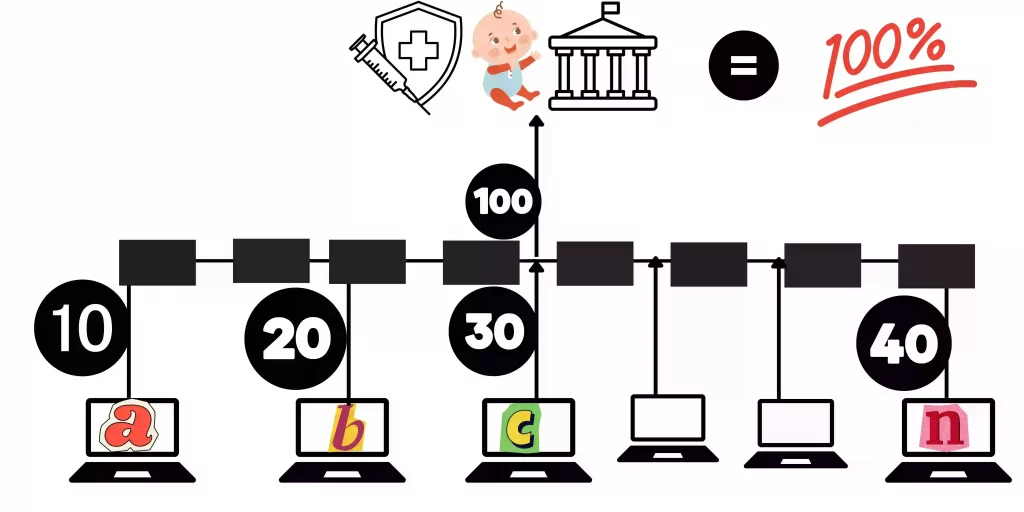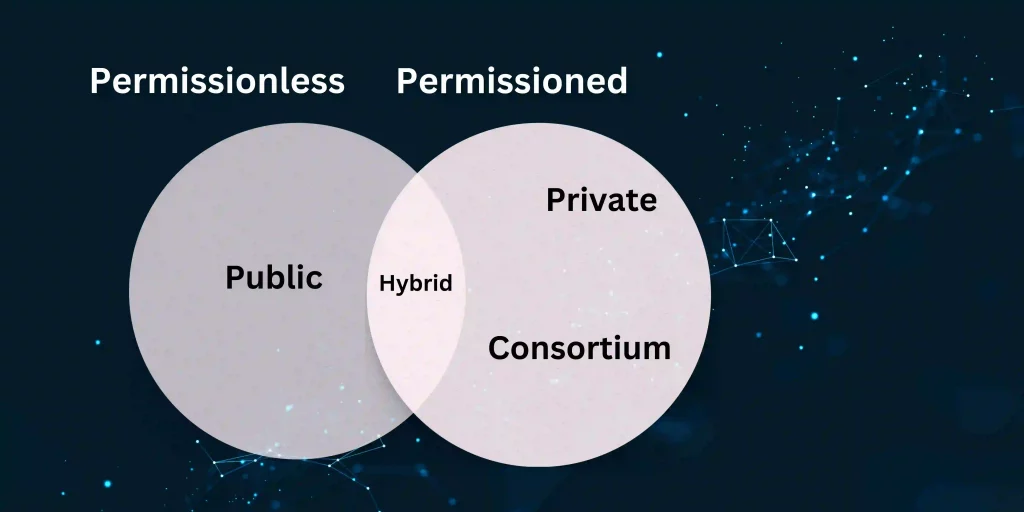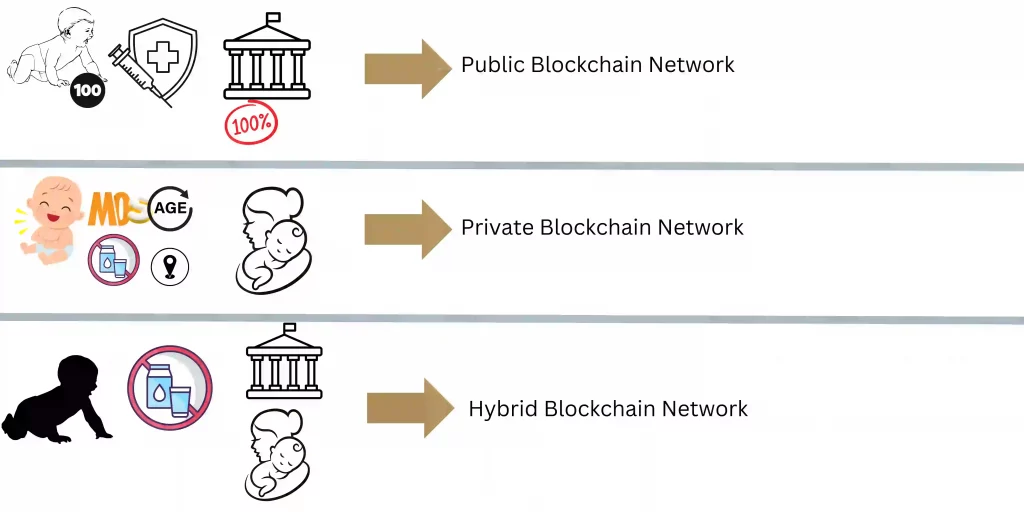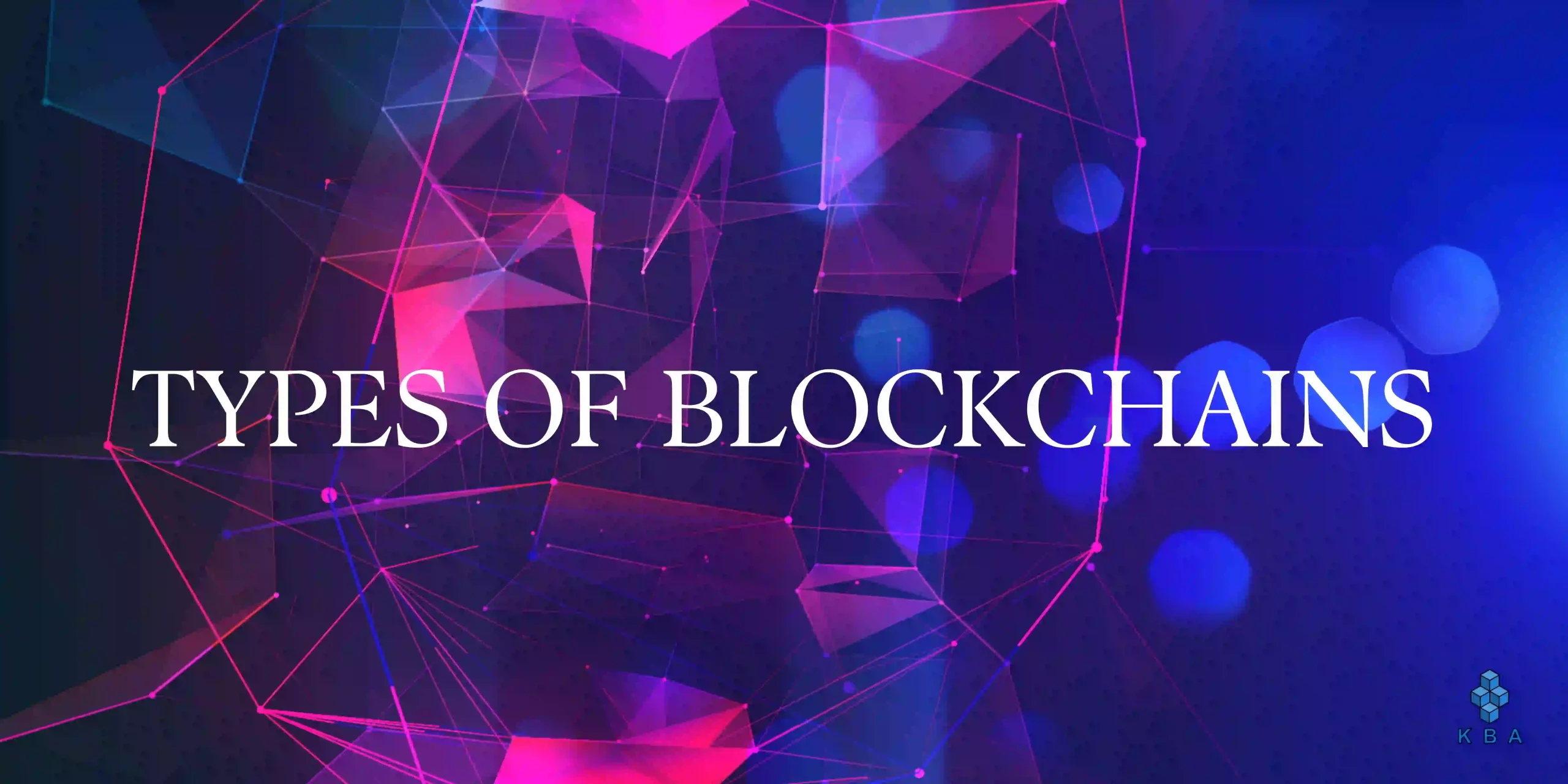Blockchain is a decentralised database that records every transaction happening on the network. The blockchain network enables its users to do transactions without any intermediaries. To verify the correctness of the transaction, the nodes (users) broadcast it in the network. If the majority of nodes agree upon the transaction, it is added to the blockchain.
In this blog, we will discuss the types of blockchains and where they are widely advocated. So, before delving into the types of blockchain, let’s understand the basic conceptualisation of blockchain networks.
Blockchain Architecture Simplified
In a blockchain, transactions are grouped and stored in units called blocks, and each block contributes to the formation of a blockchain. Each block is cryptographically sealed with specific protocols to resist tampering. Data within the block is linked using a cryptographic hash value, making it time-stamped and tamper-proof.
Types of Blockchain
Blockchains are categorised based on their requirements. We know that blockchain securely transacts the data or information which any node can access. However, the same access can be regulated to a limited number of nodes upon requirement. Based on the access control, blockchain networks are classified as permissionless and permissioned. In a permissionless blockchain, every node can access the transaction details stored on the network. In the permissioned blockchain setup, the same transaction details are concealed to a group of nodes based on the network design. Let’s get to know more about the classification in detail.
Permissionless blockchain
It has no central authority and is an open network. It enables anyone to participate through a proper network connection. However, it lacks privacy and consumes a lot of energy due to its heavy load of users.
For a better understanding, let’s consider infant immunisation records. The data of every individual is private. However, the government requires it in numbers for identifying the reach of vaccination and to calculate stock availability. For example, if there are 100 infants to be immunised and there are n number of immunisation centres. Using public blockchain technology, every immunisation centre collects the data and publishes it on the official website.

Here, each immunisation centre updates the total number of babies immunised using the public blockchain network. That means node a=10, b=20, c=30, and n=40, which means 100 infants are immunised. The respective government publishes the data, stating 100% infant immunisation. However, in this case, the information entered in the permissionless system is not sensitive, so it doesn’t affect the child’s privacy. Permissionless blockchains are open to the public. Therefore, every network user can verify the government-added information on the blockchain.
Need for a permissioned blockchain network?
In our example, the total number of infant immunisations is made public. Here, the immunisation centres and the government concealed the private information of each child. So, once the regional centre enters the data, it is tamperproof due to the unlimited number of nodes keeping the same data.
But there is a lot of sensitive information that needs to be strictly regulated. For example, the date of birth or other health information of the child. If we publicise them on the permissionless network, anybody can access such irreversible information. Considering such data breaches, permissioned blockchains are conceived.
Permissioned blockchain
Permissioned blockchains are closed, and only the member nodes can validate the transactions. It is highly secure, scalable, and private, managed by a private authority. It stays decentralised among its permissioned network participants. Permission is required to access the network, which is controlled by an administrator. As the authorities can change the privacy settings of the network, it reduces the decentralisation feature of blockchain network ideology.
Permissioned blockchain network- a fictional case study
To understand it better, let us consider the previous example of the infant immunisation drive. It is necessary for the individual to keep a record of their health-related information. Let us consider the immunisation status of an infant out of 100. For the convenience of understanding let’s fictionally name the infant: Mos, a male child. Using a permissioned blockchain network, the immunisation centre scans the name of a particular vaccine in the personal profile of Mos.

Here, information about Mos, including his photo, gender, date of birth, name of his parents, address, blood group, and other private information is stored in the permissioned blockchain network. This is a typical example of a private blockchain network. With a permissioned blockchain, the level of information sharing can be controlled. With the consent of parents, the sensitive information can be exchanged for further health-related needs of the child.
Permissioned blockchains have limited access; therefore, it increase the network speed. Since the information is shared only between the member nodes, the trust level will be high. Permissioned blockchains are decentralised only among the limited member nodes. With pre-set rules and regulations, permissioned blockchains ensure data confidentiality.

Public blockchain: A permissionless blockchain network
The public blockchain is a permissionless blockchain, and any node can access the network. The data is available on the public network, and anybody can read, edit or write data in this blockchain network. So, the network nodes will have indisputable proof to prove the manipulation. Ethereum and Bitcoin are renowned public blockchains. High energy consumption, scalability, and a lower throughput are the drawbacks of the public blockchain network.
Advantages and disadvantages of public blockchains
In our example, once the data of the total vaccinated infants is published, it is irreversible. Sometimes, the chances of external spies manipulating the data or the administrators fabricating the information are high. With the data decentralisation property of public blockchain technology, the network eliminates such malicious activity. It means that, once the vaccination data is entered, it is unalterable. So, blockchain technology ensures factual and real-time data.
There are some limitations to this public blockchain networking. The foremost is its scalability issue and high time consumption. With the large scale of nodes participating in the blockchain network, more energy is needed. So considering the time consumption and resource wastage, it is not economically feasible. If the information is sensitive, permissioned networks like private blockchains can be adopted.
Private blockchain- the permissioned network
The private blockchain is permissioned and restricted to a limited number of nodes, or rather, to specific interest groups. The data distribution is limited to a fixed number of nodes. It is used in business or organisational environments that advocate limited data sharing. Hyperledger, Ethereum Enterprise and R3 Corda are some of the private blockchains. The use cases include verification of assets, supply chain management, financial services, healthcare, government services, retail, insurance, real estate etc.
Pros and cons of the private blockchain network
This network is secure, ensuring data privacy. Since the nodes participating in this network are smaller, it guarantees high speed. The network is eco-friendly, power-efficient and cost-effective. Through the private blockchain network, sensitive information is not publicised. In a way, it is decentralised, with limited access among Mos’s guardians and his health care providers.
However, if the upcoming vaccine is not advised for lactose-intolerant children, then the officials should identify such children and inform them accordingly. A hybrid blockchain network advocates such a philosophy.
Hybrid blockchain network, an overview
Hybrid blockchains are a mixture of public and private blockchain networks. In this, there will be a public data-based system alongside a permissioned or restricted blockchain space. Limited users will get access to sensitive data within a public network. This type of blockchain is more scalable than a public blockchain network. It is highly recommended in real estate, retail businesses, and regulated markets.
Use case of hybrid blockchain network
It is partially decentralised by maximising the advantages of public and private blockchain systems. Let us consider the previous examples of infant immunisation to understand the lactose intolerant case.

Here, the public blockchain network publicised 100 infants as a number, and the government deduced a 100% infant immunisation rate from the data. In the private blockchain network, the personal information of each child is available. We considered the case of Mos, the male child in the permissioned blockchain network, which is a private blockchain network.
In the hybrid blockchain network, only the information regarding Mos’s lactose intolerance is shared as permissioned access. So, the rest of the sensitive information is not shared with the third party, which gives privacy to Mos. There is sensitive information or innovations between organisations as well. Consortium blockchain efficiently tackles such organisational exchanges. The following section will give an overview of the consortium blockchain network.
What is consortium blockchain?
Consortium blockchains are also called ‘federated blockchains’. It is a decentralised network since it involves the collaboration of various organisations. Here, the consensus mechanism is followed by predetermined nodes. The designated node is responsible for initiating, receiving, and validating the transactions. The semi-private blockchain network accepts only pre-determined participant nodes.
Benefits and limitations of consortium blockchain
Consortium blockchains are more secure, scalable, and efficient than public blockchains. It has access control similar to that of private and hybrid blockchains. With a low degree of transparency and infiltration, it is commonly used in banking and other payment-related operations.
Consortium blockchain is intended for innovative collaboration between enterprises. If a member node initiates hacking, the specific node will become inoperable. So, in industries like food tracking, consortium blockchain improves trust and ensures transaction security. To know more about blockchain and courses on blockchain technology contact us now!
Conclusion
Every type of blockchain has its own benefits and shortcomings. Blockchains are not appropriate for data modification. It means if a business firm intends to change the data, then the unalterable features of blockchain networks are not ideal for them. Permissionless public blockchains save copies of transactions at multiple nodes. So, unlike permissioned or private blockchains, which are restricted to a limited number of nodes, permissionless blockchain is tamperproof.
Blockchain is not recommended if the trust between the nodes is strong in an organisation or if a single authority handles the data. Blockchains guarantee the accuracy of unaltered data. The public blockchain, private blockchain, hybrid blockchain or consortium blockchain can be adopted based on the requirements and nature of an enterprise.

